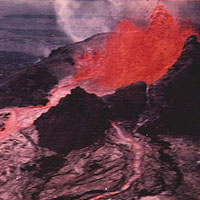BIOL 1400 -- Lecture Outline 11
"This world may be only illusion -- but it's the only illusion we've got."
--Edward Abbey
I. Life Through Time: Reading the Fossil Record
- Charles Lyell: ". . . the present is the key to the past."
- It was becoming increasingly clear that the Earth was much older than anyone
had suspected. (There had to be a lot of time to accommodate the growing number of
extinct organisms, and the great changes in biodiversity.) How old, no one was sure. . .
- But how to interpret the rocks? Building on work by many other geologists, a
19th-century English lawyer-turned-geologist named Charles Lyell formulated
the principle of uniformitarianism.
- This is a complex topic, because the word "uniformitarianism" has several
different shades of meaning, most of which we're not going to go into.
- But in its modern form, it can be stated like this: Present-day processes,
which can be observed now, can be used to explain past events. In other words:
"The present is the key to the past."
- Example: You can go to, say, Hawaii, and watch molten lava cool and harden
into black rock called basalt.

Lava eruption and basalt at Pu'uo'o, Kilauea, Hawaii
If you find similar rock elsewhere -- even if there's no volcano anywhere near -- it
is most reasonable to assume that it was made by the same process.
- Other examples of this type of reasoning were in the slide show, such as the
ripple marks in both beach sand at low tide and in ancient sandstone. . .
- There are times when geologists make exceptions. This is not an iron-clad law!
But uniformitarianism is very good at generating testable hypotheses.
II. Voyage of the Beagle. . .
- In 1831, British naval captain Robert Fitzroy was preparing a surveying
and mapping mission to the coasts of South America.
- He took along a recent university graduate with a strong interest in
biology and geology, by the name of Charles Darwin. . .
- The Beagle sailed around the world, taking almost five years (1831-1836).
Most of the voyage was taken up by surveying the coasts of South America.
- Darwin collected fossils in South America, and noticed that they seemed
oddly similar to the living organisms that were, and are, native to South America.
Example: The fossils of glyptodons and giant sloths look like giant versions of
living armadillos and tree sloths.
- On the home stretch, the Beagle briefly stopped at a few small
islands about six hundred miles off the Pacific coast of South America:
the Galàpagos Islands
- The Galàpagos Islands are volcanic islands -- some of the volcanoes
are still occasionally active -- and they're relatively young compared to the
mainland.
- These islands have many species that are unique to themselves -- but at
the same time, that resemble South American species. Examples: prickly pear
cactus trees; marine iguanas; giant tortoises, big enough to ride but still much
like the gopher tortoises of the Americas; unique kinds of seagulls and mockingbirds. . .
and many more.
- What's more, in many cases, different islands had different species.
- Example: Each island, and in some cases each separate mountain peak on the
same island, has a giant tortoise with a differently-shaped shell.
- Example: There are fourteen species of finch on the islands, each of which
feeds on a different food source and has a beak adapted to that food source.
- This raises the question: What is all this diversity doing here?
- And back sailed the Beagle. . .
Go to Previous Notes |
Return to Lecture Schedule |
Return to Syllabus |
Contact the Prof |
Go to Next Notes
